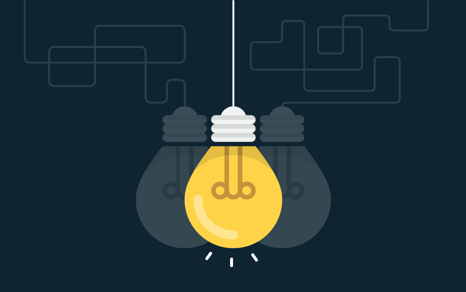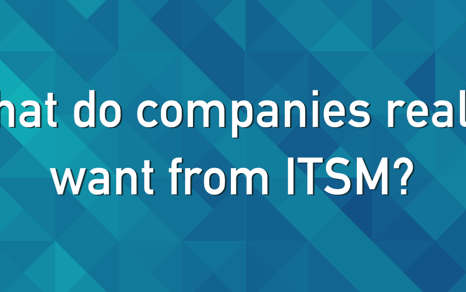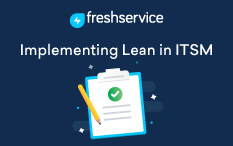What is ITIL?
Breaking down IT service management and related concepts


Information Technology Infrastructure Library, ITIL is defined as a framework with a set of best practices for delivering efficient IT support services. It enables organizations and individuals to deliver cost-effective IT Service Management, ITSM aligned with business vision, strategy and growth and acts as a single point of contact between service provider and end users. While ITSM helps businesses to achieve their mission and vision with the right mix of process, technology and people, ITIL guides the way IT services are managed and delivered. Digital transformation and technology initiatives are guided by the best practices of ITIL. Companies adopt ITIL to realize their business benefits faster with defined processes and enabled by the right technology. ITIL aims for resource optimization and reviews existing processes continuously to improve. It also acts as a business partner for organizations to adopt only those practices that are relevant for them.
ITIL, since its inception in 1980, has continuously evolved into many versions and currently has 5 books. ITIL was first developed by the British government's Central Computer and Telecommunications Agency (CCTA) in the 1980s. Over the years, it has undergone multiple revisions that aim towards business alignment and improved efficiency. The first ITIL book was published in 1989 followed by a V2 in 2000. While V3 came out in 2007, a more up-to-date variant of V3 was published in 2011. The latest edition of the ITIL book is expected to release later this year and it is expected to cover methodologies like Devops, agile and lean.
ITIL certification is owned by Axelos and it has five levels with specific training content. ITIL certification is available for individuals to gain expertise on key focus areas of ITIL and become an expert. ITIL certification has five tiers and ITIL foundation certification is the entry level and this covers basics of ITIL terminology, ITIL service lifecycle.
ITIL Foundation certification is targeted at anyone who needs a basic understanding of key concepts and processes in ITIL service lifecycle and service management best practices. It is aimed at delivering the following
The certification can be taken by anyone who wants to learn about ITIL processes and there is no eligibility criteria. ITIL foundation acts as a prerequisite to take other level exams. This enables individuals to start their career path in IT profession.
Start your 21-day free trial. No credit card required. No strings attached.
ITIL framework consists of five stages as a part of service lifecycle. Each stage consists of a set of processes or functions that are aligned with IT organizational structure. Companies adopt some of these processes that are suitable for their teams. ITIL is therefore flexible in terms of adoption. Following is the ITIL service lifecycle stages
Facilitates organizations to set business goals and develop a strategy to meet customer requirements and priorities.
Includes designing of processes and functions. This covers designing of service management processes, technology, infrastructure and products.
Focuses on maintaining the current state of service while deploying new organizational change. It ensures that risk and impact are in control so that there are no interruptions to any ongoing services.
Service operation ensures day to day operational tasks are seamless and is responsible for monitoring infrastructure and application related services. This enables businesses to meet customer’s requirements and priorities.
This is a part of quality check that aims towards continuous improvement of processes in an incremental manner. This happens throughout the service lifecycle.

ITIL framework consists of five stages as a part of service lifecycle. Each stage consists of a set of processes or functions that are aligned with IT organizational structure. Companies adopt some of these processes that are suitable for their teams. ITIL is therefore flexible in terms of adoption. Following is the ITIL service lifecycle stages
Businesses implement new projects or applications on a day to day basis. It is important to analyze risk and impact before carrying out the planned activities. Based on the risk and impact, change approvals are planned including all relevant stakeholders. Change management records every detail of change that is requested for better tracking and audit. Change management is crucial for an organization in order to effectively deploy new implementations without any downtime. Post implementation review is done to keep things in control.
Business users expect smooth business operations without any disturbance. However, in reality it is a challenge to achieve with the available complex infrastructure components and applications. Proactive approach to incident management deflects redundant tickets and also eliminates major incident occurrence. Automation handles ticket classification and assignment so that service desk agents focus on higher priority activities. ITIL Incident management works in close association with Configuration Management Database, CMDB to link the asset related to the incident.
Repetitive issues are handled by Problem management team to analyze the root cause and find a permanent fix. Problem manager performs the Root Cause Analysis, and suggest a temporary workaround until permanent solution is deployed. Proactive problem management is adopted by many organizations to prevent any potential damage caused by major outages and ensure service availability. It is recommended to understand the difference between incident and problem management to assign clear roles and responsibilities.
ITSM and ITIL are not mutually exclusive. IT Service Management, ITSM defines how IT services are managed efficiently and adding value to customers. Companies may not realize that they are doing ITSM but whenever IT systems and IT infrastructure are present, ITSM is performed inevitably. ITIL enables companies to achieve efficient ITSM. ITIL is a framework with a set of best practices that are adopted by businesses and individuals for business transformation and strategic IT. ITIL suggests ways to improve and optimizes resources in order to provide real value to customers.
“ITSM is how you manage IT and ITIL guides businesses for efficient ITSM”.
Start your 21-day free trial. No credit card required. No strings attached.
ITIL is not project management to implement across organization and there is no one-size-fits-all approach. Depending on the business needs, ITIL can be customized and adopted easily.
First and foremost, understand the problems that you are trying to solve and objectives of ITIL. It is important to align business objectives with ITIL objectives. Therefore, understand the benefits that ITIL has to offer and focus on customer priorities. Communicate the value of ITIL to all department heads so that ITIL awareness is present across organization. Try for ITIL certification as it allows individuals and businesses to gain expertise around ITIL. ITIL aims at adding real value to your IT investment and monitors the Infrastructure & Operations, I&O.
Before implementing ITIL, analyze the current process maturity to identify process improvement areas. We might be doing ITIL in some form and therefore it is significant to understand the existing processes. Based on the business priorities, close the gap by adopting relevant ITIL processes. Process maturity assessment has to be realistic to achieve desired outcome.
People are more important than process and technology capabilities. Identifying the roles and responsibilities of process owner is crucial. ITIL success depends a lot on service desk agents’ attitude and soft skills besides technical skills. ITIL demands a lot of collaboration among various functions and therefore people skills are important before hiring for service desk agents.
ITIL does not force companies to implement all the 26 processes whereas it is recommended to start with necessary processes such as incident management, knowledge management and move to other processes after initial success. Communicate about ITIL to all relevant stakeholders and process capabilities.
Continual Service Improvement, CSI is necessary from an operational standpoint. Reviewing the current process maturity helps in identifying process gaps. CSI happens throughout ITIL service lifecycle right from ITIL service strategy. ITIL is an ongoing project which is reviewed and improved throughout. This also helps in aligning business goals with ITIL goals.
ITIL has varied benefits for IT and business. ITIL enables companies to be more agile complementing other best practices and frameworks. ITIL acts as a driver for efficient IT Service Management. Following are some of the benefits

The Paradigm Shift In ITSM

5 Hacks for Good IT Service Management

Achieving World-Class ITSM Experience

Don’t Overcomplicate ITSM

Connecting The Dots – ITSM with ITAM

5 life lessons about implementing ITSM tools

What do companies really want from ITSM?

Moving from reactive ITSM to proactive ITSM

ITSM for higher education

Improve the efficiency of your IT team by implementing Lean in ITSM

Expectations are Good

The No-nonsense Guide to ITSM